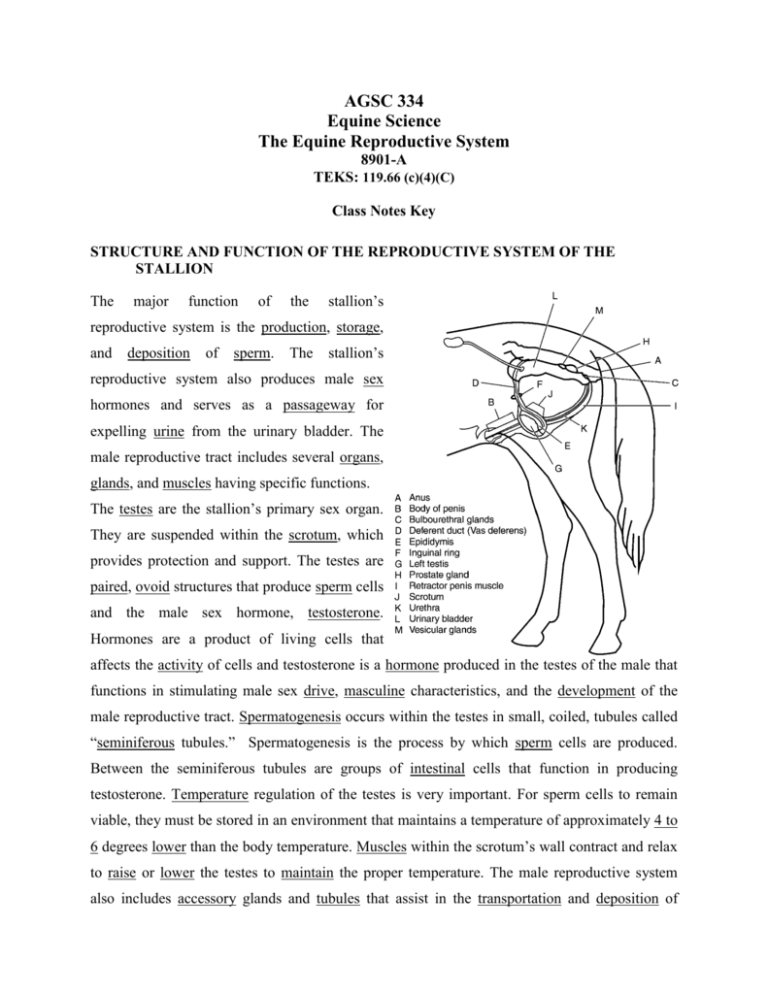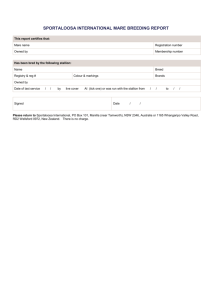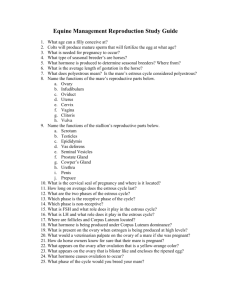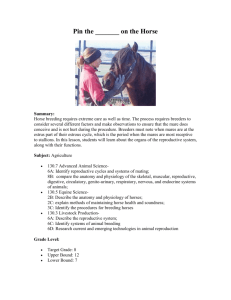AGSC 363
advertisement

AGSC 334 Equine Science The Equine Reproductive System 8901-A TEKS: 119.66 (c)(4)(C) Class Notes Key STRUCTURE AND FUNCTION OF THE REPRODUCTIVE SYSTEM OF THE STALLION The major function of the stallion’s reproductive system is the production, storage, and deposition of sperm. The stallion’s reproductive system also produces male sex hormones and serves as a passageway for expelling urine from the urinary bladder. The male reproductive tract includes several organs, glands, and muscles having specific functions. The testes are the stallion’s primary sex organ. They are suspended within the scrotum, which provides protection and support. The testes are paired, ovoid structures that produce sperm cells and the male sex hormone, testosterone. Hormones are a product of living cells that affects the activity of cells and testosterone is a hormone produced in the testes of the male that functions in stimulating male sex drive, masculine characteristics, and the development of the male reproductive tract. Spermatogenesis occurs within the testes in small, coiled, tubules called “seminiferous tubules.” Spermatogenesis is the process by which sperm cells are produced. Between the seminiferous tubules are groups of intestinal cells that function in producing testosterone. Temperature regulation of the testes is very important. For sperm cells to remain viable, they must be stored in an environment that maintains a temperature of approximately 4 to 6 degrees lower than the body temperature. Muscles within the scrotum’s wall contract and relax to raise or lower the testes to maintain the proper temperature. The male reproductive system also includes accessory glands and tubules that assist in the transportation and deposition of sperm into the female reproductive tract. Accessory glands are responsible for the production of secretions that contribute to the non-cellular, fluid portion of semen. Semen is fluid secretions that consist of sperm suspended in fluids from the accessory glands. Accessory glands include the vesicular glands, prostate gland, and bulbourethral glands. These glands furnish fluids that help to nourish, protect, and transport semen. The male’s system of tubules includes the epididymis, deferent ducts, and urethra. The epididymis is a coiled tube connected to each testis that is responsible for maturation, storage, and transportation of sperm cells. The deferent ducts originate from the epididymis and serve as a passageway for sperm to the urethra. Upon ejaculation, sperm travel through the urethra to the end of the male genitalia and into the female reproductive tract. Ejaculation is discharge of semen from the penis. The penis is the organ that allows for deposition of semen into the female reproductive tract. The stallion’s penis is a vascular-type penis; it depends on the engorgement of blood for erections to occur. Stallions can normally ejaculate from 25-150 milliliters of semen. The volume of semen produced depends on the following factors: season of year, frequency of ejaculation, and stallions’ age and testicular size. Semen is grayish white and consists of seminal fluid and sperm cells. The number of sperm cells in an ejaculate usually ranges from 10-15 billion. The total number of progressively motile spermatozoa in a “good” ejaculate is usually about 60-70%. Motile means exhibiting or capable of movement. A sperm cell may live in a mare’s tract for 24-48 hours. Sperm may travel to the mare’s oviduct in as short a time as 15-18 minutes after breeding, but the normal time is 5-8 hours. STRUCTURE AND FUNCTION OF THE REPRODUCTIVE SYSTEM OF THE MARE The major function of the mare’s reproductive system is the production of ova or eggs to be fertilized by sperm. It also serves as a receptacle for the penis during copulation and houses and nourishes the fetus until parturition. The fetus is the unborn young of an animal after it has taken form in the uterus. Parturition is the process of giving birth. Complex hormonal actions and interactions along with cooperation from other body systems must take place in a mare to accomplish these reproductive functions successfully. The major reproductive organs of the mare include the ovaries, oviducts (fallopian tubes), uterus, and vagina. The ovaries are paired, ovoid structures that function in the production and release of ova through the process of oogenesis. Oogenesis is proliferation, growth, and maturation of ova. The ovaries also produce the female hormones estrogen and progesterone. Estrogen is a hormone produced by developing follicles on an ovary of a female that functions in stimulating the development of secondary sex organs and sexual receptivity. Progesterone is the hormone produced by the corpus luteum on an ovary during pregnancy and which keeps estrus from occurring and causes the mammary system to develop. These hormones play a vital role in the conditioning of the reproductive tract for implementation of the fertilized ovum and care of the fetus. The ovum is the egg. The oviducts are the paired tubes that serve as the connections between the ovaries and the uterus. When an ovary releases an ovum, the oviduct transports it from the ovary to the uterus. Each of the two funnel-like openings of the oviducts is called an infundibulum, which picks up the ovum at ovulation and directs it into the body of the oviduct. Ovulation is the process of discharging an ovum from the mature follicle of an ovary. The oviduct is the normal site of fertilization of the ovum by sperm. The uterus of the mare consists of two horns. The mare has short uterine horns in relation to other livestock species. The fertilized egg normally implants in the lining of one horn of the uterus and receives nourishment during its development until parturition. The uterus functions as a passageway for sperm during copulation, incubates the embryo during pregnancy, and contracts to expel the fetus during parturition. Copulation is the physical procedure of natural mating between a male and female of the same species. The vagina serves as the receptacle for the penis during copulation and also as the birth canal at parturition. The uterus is separated from the vagina by the cervix. The cervix is the thick-walled mass of connective tissue with a small tube-like opening that serves as a passageway for the semen from the vagina to the uterus at copulation. The vagina also serves as a passageway for expelling liquids wastes, as the urethra joins the bladder to the vagina prior to opening at the vulva. The vulva is the external portion of the female reproductive tract. Just inside the vulva is a sensory erectile organ called the clitoris. REPRODUCTIVE CYLE OF THE MARE Mares are seasonally polyestrous. This means that mares go into heat only during specific seasons of the year, and she goes into heat more than once during that period. Most mares do not cycle during the winter. This winter anestrus varies in length depending on the climate. Anestrus is a period of time when a female is not cycling. Some mares cycle throughout the year, especially in areas not having definite seasons. Most mares, however, only go into heat through the spring, summer, and into the fall. Hormones control a mare’s estrous cycle. The estrous cycle is generally defined as the time between two consecutive estrus periods. An increase in daylight, improved nutrition, and warmer temperatures activates the hormones and control the estrous cycle. The estrous cycle includes estrus, a period in which the mare shows outward signs of receptivity to breeding as a result of hormones secreted. Outward signs shown by the mare include acting nervous and frequent urination. All the factors that can activate the relevant hormones are associated with springtime. These factors indirectly stimulate the pituitary gland in the brain to secrete follicle stimulating hormone (FSH). FSH travels in the bloodstream to the ovaries, where it stimulates the development of an ovum. The ovum develops in a vesicle in the ovary, which also secretes the hormone estrogen. A vesicle is small, thin-walled cavity. Estrogen prepares the mare’s reproductive tract for mating, and it also makes the mare receptive to the stallion for breeding. Further, estrogen inhibits the pituitary gland from secreting more FSH. This is very important, since further FSH secretion would cause another ovum to start developing. The pituitary gland secretes luteinizing hormone (LH) as well as FSH. LH stimulates the ovary to release the egg. The ovary releases the egg during the last part of estrus. This period usually last about five days. During this time, the mare is receptive to the stallion and is willing to breed. After ovulation, LH is responsible for the formation of the corpus luteum (yellow body) at the place on the ovary where the ovum originated. The corpus luteum secretes the hormone progesterone, which prevents the maturation of new follicles. Fertilization is the union of the sperm and the ovum. If fertilization occurs successfully, the corpus luteum continues to secrete progesterone, which maintains the pregnancy until parturition. After parturition, the corpus luteum on the ovary begins to regress, a developing follicle on the ovary begins to release estrogen, estrus occurs and the estrous cycle begins once again. If fertilization does not occur, in about two weeks the uterine lining starts secreting the hormone prostaglandin. Prostaglandin causes destruction of the corpus luteum, a reduction of progesterone secretion, and therefore an increase in FSH secretion. At this point, the estrous cycle begins again. Control of the Estrous Cycle Horse people often try to rearrange the heat cycle of the mare for convenience and higher reproductive efficiency. The basis of race and show horses’ age is the calendar year, so these horses’ common “birthday” is January 1, no matter when an individual was actually born. The closer that foaling takes place to January 1, the older an individual will be relative to others in its age division. To foal close to January 1, one must breed a mare near February 1. Since this is contrary to the mare’s natural heat cycle, horse people must use natural and chemical persuasion to alter mare’s normal estrous cycles. Heat, artificial light, and improved nutrition may all help to simulate summer conditions and stimulate heat in mares. The methods are not always dependable or profitable, however. Chemical control techniques are useful to stimulate cycling and control ovulation. These techniques require synchronization of ovulation with estrus. If ovulation and heat are synchronous, then one can breed the mare once and have a very good chance of the mare settling. Settling indicates when the female has been bred successfully. This procedure would save many hours of teasing, palpation, keeping records, and other chores that go with normal breeding. Two hormones are useful for achieving this goal: human chorionic gonadotropin (HCG) and prostaglandin. HCG is useful for controlling ovulation, and prostaglandins induce estrus and control the lifespan of the corpus luteum. A program utilizing both hormones may help save labor and produce more foals in large breeding establishments. REPRODUCTIVE FAILURES Sterility, either permanent or temporary, may be caused by a number of reasons in both stallions and mares. Specific physical defects, particular diseases, environmental factors, or nutritional aspects can affect reproduction processes. When other body systems have problems, the reproductive system may not function properly until the other problems are corrected. SUMMARY The major function of the stallion’s reproductive system is the production, storage, and deposition of sperm. The male reproductive tract includes several organs, glands, and muscles having specific functions. The major function of the mare’s reproductive system is the production of ova or eggs to be fertilized by sperm. The major reproductive organs of the mare include the ovaries, oviducts (fallopian tubes), uterus, and vagina. Most mares only go into heat through the spring, summer, and into the fall. Horse people often try to rearrange the heat cycle of the mare for convenience and higher reproductive efficiency. The methods are not always dependable or profitable, however. Physical defects, diseases, environmental factors, or nutritional aspects can cause temporary or permanent sterility in mares and/or stallions.






